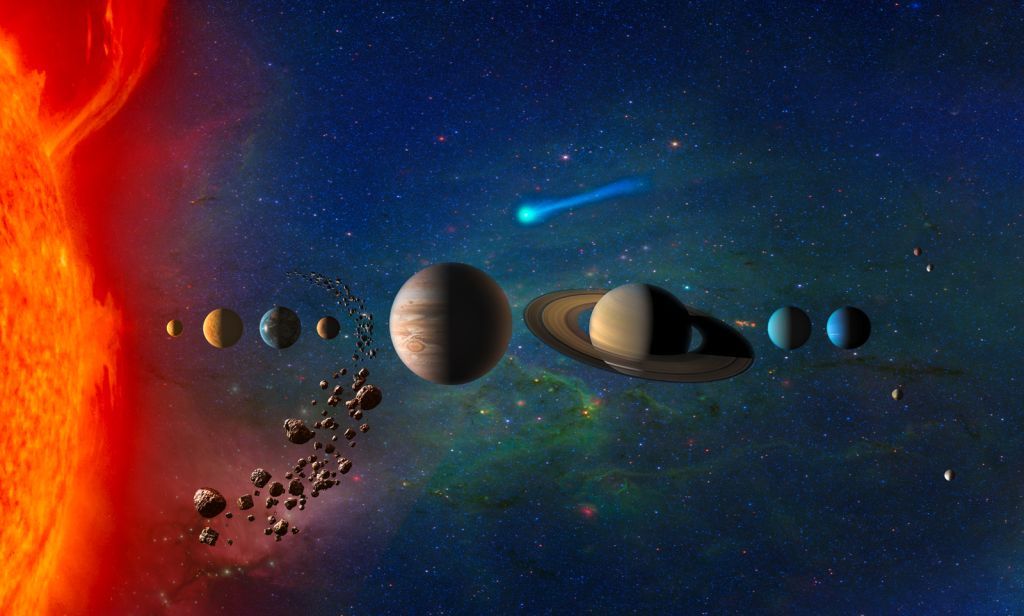50 Super Cool Space Facts That Will Amaze You!
Interesting Space Facts That May Surprise You!
The subjects of Space and Astronomy are the most fascinating in the universe! They are also topics we are only beginning to understand as there is still a lot we don’t know about it! However, some of the facts we do know about Space, Astronomy and its Exploration are fascinating and simply mind-boggling! Check out 50 of the most amazing facts about space that will inspire you and that you can share with your friends and family.
50 Fun And Mind-Boggling Space Related Facts!
- The Soviet satellite Sputnik, which launched on October 4th 1957, was the first artificial satellite to orbit the Earth. This event also signalled the start of the Space Race!
- The first American satellite called Explorer 1 was launched 4 months later on January 31st, 1958.
- The Soviet Cosmonaut Yuri Gagarin became the first man in space on April 12th, 1961 aboard his Vostok spacecraft.
- On Feb. 20, 1962, John Glenn became the first American to orbit the Earth in his capsule named "Friendship 7."
- Soviet cosmonaut Valentina Tereshkova became the first woman to fly to space when she launched on June 16, 1963.
- Early in the Apollo program, the astronauts gave nicknames to their spacecraft. Apollo 10's crew named their command module (CM) "Charlie Brown" and the lunar module (LM) "Snoopy"!
- The first manned lunar landing mission, Apollo 11, landed on the Moon on July 20, 1969, after the three-day trip to the Moon. During this mission, Neil Armstrong became the first human to walk on the surface of the Moon.
- During the Apollo 14 mission, Alan Shepard hit 3 golf balls while on the Moon!
- Of the nine Apollo missions, six landed on the moon - Apollo 11, 12, 14, 15, 16, and 17 before the program was cancelled.
- Did you know that 24 men have travelled to the Moon? Three of those men (John Young, Eugene Cernan and Jim Lovell) have travelled to the Moon twice!
- Twelve of the 24 men that travelled to the Moon have walked on the lunar surface.
- Did you know that since the Moon doesn't have an atmosphere, there's no wind or water to erode or wash away the astronauts' footprints or equipment so they will likely stay there for millions of years!
- On the 12th of April 1981, the Space Shuttle Columbia became the first Shuttle to launch into space - 20 years to the day after the first human flew in space.
- Can you hear in outer space? Unfortunately No, because there is no atmosphere for sound waves to travel through. So an object would make a noise, but it would not carry across space so you couldn’t hear it.
- Did you know that the International Space Station (ISS) travels at 28,200 kilometres per hour (or 17,500 mph)? That’s crazy fast! At this speed, it completes an orbit of Earth every 92 minutes! That means the astronauts see 16 sunrises and 16 sunsets every day!
- Seven paying ‘space tourist’ have paid between $20-40 million each to launch themselves to space and visit the ISS.
- The longest consecutive stay in space is an amazing 438 days by cosmonaut Valeri Polyakov aboard the Mir Space Station! See more Space Traveller Records.
- Did you know when you look up at the Milky Way in the night sky, that you are looking towards the dense centre of our own galaxy where most of the stars in the Milky Way Galaxy reside?!
- Stars don’t actually twinkle; they just appear too due to the atmosphere slightly warping the distant stars faint light.
- The Sun takes 240 million years to complete an orbit of the Milky Way Galaxy, known as a Galactic year!
- The brightest star in the night sky is called Sirius and it would take you 8 ½ years travelling at the speed of light to reach it!
- With your naked eye, you can see about 5,000 stars in the night sky. Earth obstructs your view of about half of them, so on any one night, you can see between 2,000 - 3,000 stars.
- The energy released by a supernova is equal to the combined energy released by the Sun during its 10 billion year lifespan!
- Astronomers have discovered nearly 4,000 exoplanets orbiting other stars! Check out this link to see the latest exoplanet figure.
Space Facts About The Solar System
- The Sun, the star at the centre of our solar system, contains a whopping 99% of all the mass in the solar system. That's why everything orbits it because the Sun’s gravity dominates it.
- The Great ringed Planet Saturn has an average density less than water! That means it could float in Earth’s ocean if it was big enough!
- Mars is about half the size of Earth, but its gravity is about one-third of Earth’s. That means you could jump 3 times higher and feel like a superman because you could lift things 3 times heavier than you normally could on Earth!
- The asteroid Ceres (also referred to as a dwarf planet) is the largest asteroid in the main asteroid belt between Mars and Jupiter. It is so big it contains a 1/3 of all the rock and ice in the entire asteroid belt.
- Jupiter, the solar system’s largest planet, is so big that more than 1,300 Earth’s would fit inside Jupiter! Even its giant storm known as the Great Red Spot is twice as large as the entire Earth!
- The largest canyon in the solar system is not Earth’s Grand Canyon but is a canyon on Mars called Valles Marineris. It’s more than 4,000 kilometres (2,500 miles) long and would stretch from San Francisco to Boston!
- The average daily temperature on Venus is a sizzling 450 degrees Celsius. That’s hotter than your home oven!
- The ice giant Planet Neptune has been found to have the fastest winds in the solar system; an incredible 2,575 kilometres per hour (1,600 miles per hour)!
- Mercury is the fastest planet zipping around the Sun in only 88 Earth days at a speed of 170,500 kilometres per hour (106,000 miles per hour).
- A day on Mercury lasts 116 Earth days which is 2 years on Mercury!!
- Saturn is the second largest planet in the solar system.
- If you think Earth has a lot of volcanoes, well Jupiter’s bizarre small moon Io is the most volcanically active body in the solar system as it is covered in volcanoes and lava flows!
- Europa, one of Jupiter’s 4 large Galilean Moons is covered in a thick ocean of ice 100 kilometres thick which scientist believes covers a deep liquid ocean.
- Space probes exploring the outer solar system send tiny radio signals to contact Earth which only have the same power as a small light bulb!! That’s why we need really big satellite dishes (like the Deep Space Network) to receive these transmissions.
- It takes sunlight, travelling at 300,000 m/s, over 8 minutes to travel from the Sun to Earth!
- The Earth takes exactly 365.25 days to complete an orbit of the Sun!
- The Earth completes one rotation every 24 hours, which means the equator is moving at 1,600 kilometres an hour!
- A total solar eclipse is caused by the Moon moving directly between the Earth and Sun with the Moons shadow moving across the earth’s surface, briefly blocking out the sun during the day!
- The longest a total solar eclipse can last is 7 minutes and 30 seconds.
- It takes the Planet Neptune nearly 165 Earth years to complete one orbit of the Sun (Neptune year)!
- Did you know that the dwarf planet Pluto is ‘tidally locked’ with its large moon Charon? This means that the same side of each body always faces each other.
- Venus is the only planet in the solar system where the Sun rises in the West and sets in the East because it slowly rotates in the opposite direction to all other planets.
- Jupiter has 69 recorded moons, the most moons of any planet in the solar system.
- Ganymede is the largest moon in the solar system with a diameter of 5,268 km (3,273 miles) which makes it slightly larger than the Planet Mercury!
- The Earth’s surface is dotted with less than 200 impact craters, while Mars has over 630,000 craters with a diameter of over one kilometre!
- Did you know that some asteroids have been discovered to be orbited by their own tiny moon(s)? Fascinating isn’t it?!


Solar System
Solar System



